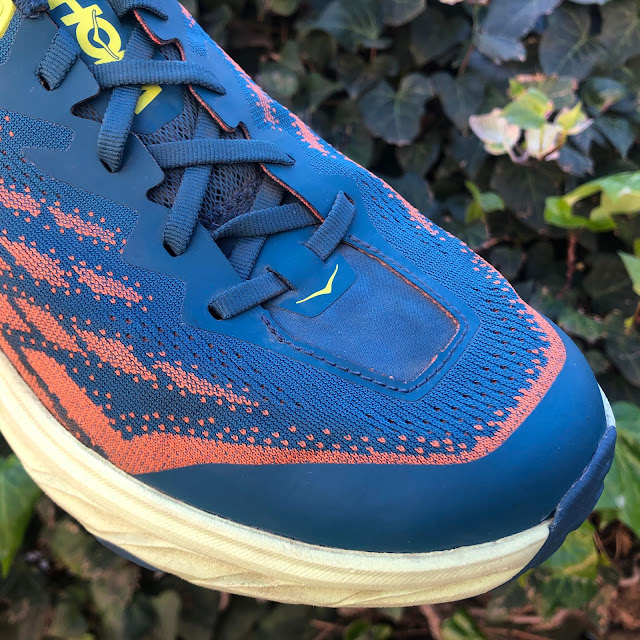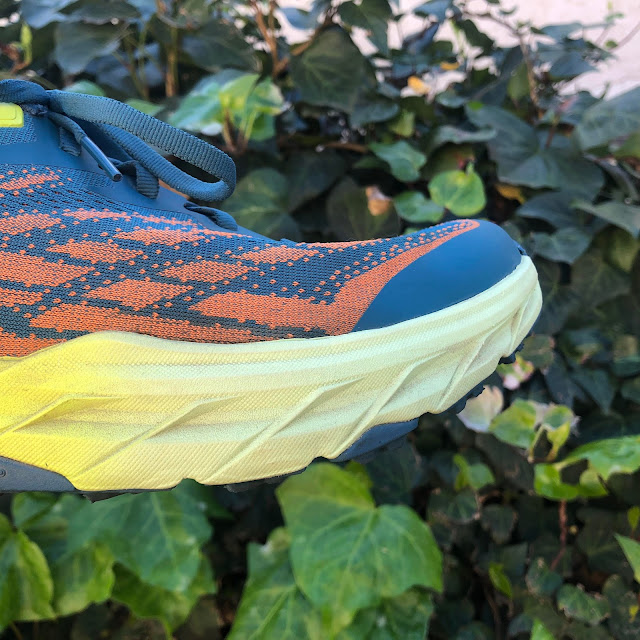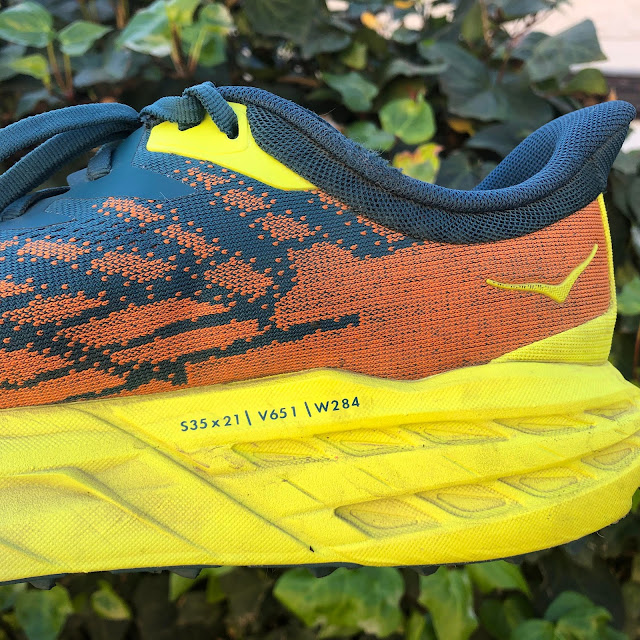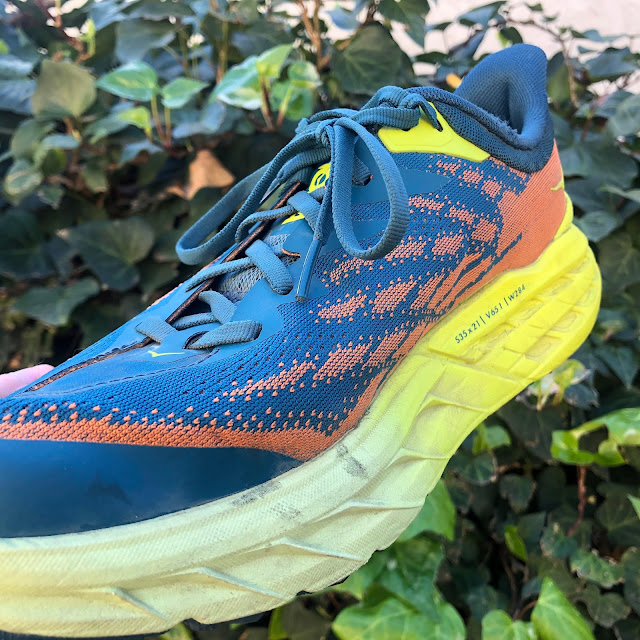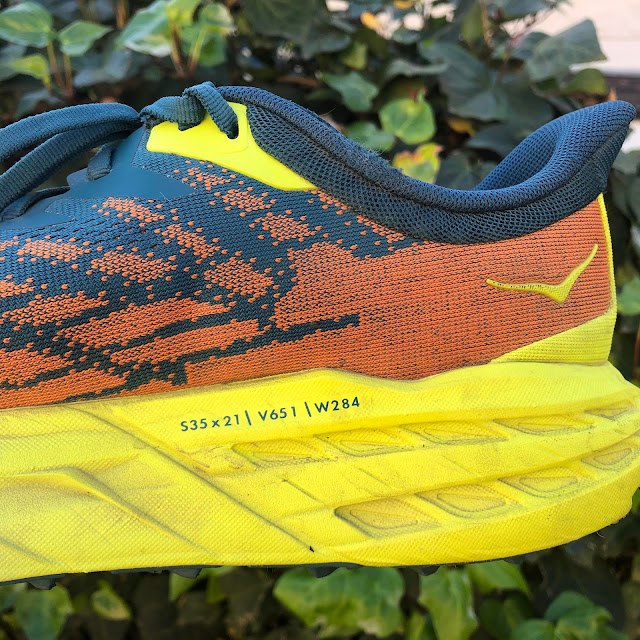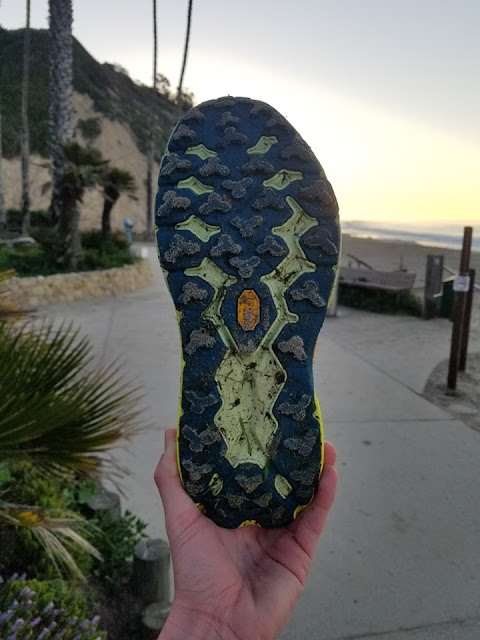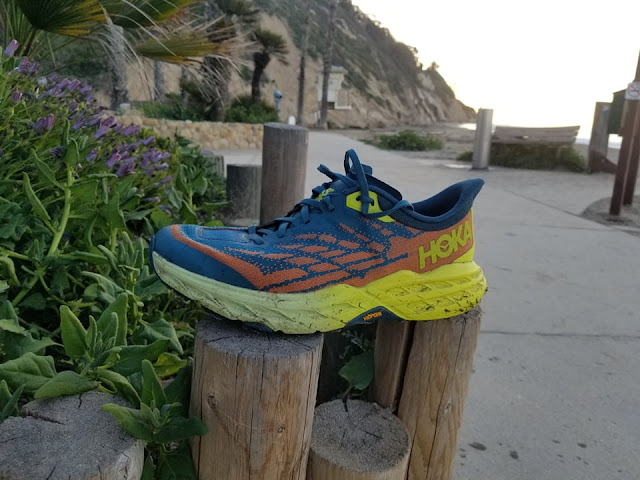By Chief Editor Matthew Klein and Contributor David Salas
The Hoka Speedgoat series has been a go-to for many trail runners, including ultra marathoning legend Karl Metzler for whom the shoe is named. A split emerged with the EVO Speedgoat version, which was a lighter and ultra trail race-worthy shoe. Many were upset when the Evo Speedgoat was discontinued and have asked repeatedly if the Hoka Speedgoat 5 is a suitable replacement. While not a complete replacement, the Speedgoat 5 merges features from the Speedgoat 4 and EVO Speedgoat into a lighter but tough trail shoe that can handle training and ultra trail racing.
Price: $145 at Running Warehouse
Weight: 10.3 oz, 291 g (men's size 9), 8.5 oz, 242 g (women's size 8)
Stack Height: M: 33mm / 29 mm; W: 31mm / 27 mm
Drop: 4mm
Classification: Maximal Trail Running Shoe
RUNNING SHOE SUMMARY
Matt: The Hoka Speedgoat 5 returns as a revamped shoe. Featuring a lighter weight (10.3 oz), enhanced outsole grip, thicker upper and a firmer but well-cushioned ride. This shoe can handle any terrain you throw at it and does best over super long efforts and bombing along trails. The well-rockered ride makes it efficient as an ultramarathon racer, while the slightly firmer ride gives it the ability to handle both daily training and uptempo paces. A stable ride offers a confident transition over unstable terrain, making it a shoe you can confidently take no matter what the trail throws at you. The Hoka Speedgoat 5 continues as a solid ultramarathon trainer/racer at a lighter weight for longer efforts.
David: The HOKA Speedgoat 5 is a high stack workhorse of trail shoe that will shine for longer mileage efforts and is very versatile with terrain. The Speedgoat 5 comes back with an updated upper as well as outsole and traction. Traditionally this has been a favorite of many in the ultra marathon trail category and I think it will remain on many people's list. The shoe is a high stack, firm but cushioned, rocker sole shoe that can tackle pretty much anything you throw at it.
PODCAST REVIEW
We discussed the Hoka Speedgoat 5 in our podcast. Click to listen on the run.
FIT
Matt: The Hoka Speedgoat 5 fits me true to size in my normal men's US size 10. The width is normal to slightly snug due to the double jacquard mesh upper. There is a taper in the forefoot that is combined with a slightly lower volume. The heel collar has an average amount of cushioning, which sits in front of a sturdy heel counter. I did not notice the heel counter when running but was slightly aware of it during other activities. Those with heel sensitivities should approach this should with some caution. The heel collar does sit a little low and I did get some heel slippage. This was alleviated by lace locking both shoes, which I would highly suggest. The tongue is gusseted in the midfoot, is thin and sits nicely against the foot. The midfoot is average in width and transitions into a slightly snug forefoot. The forefoot tapers, has a lower volume and has a moderately thick toe guard. The upper stretches around this slightly, but still feels snug and secure upfront. This is a shoe I would suggest wearing socks with as there are some overlays on the inner side. The upper durability is quite high. The double-layer handles aggressive terrain well as I have had no tearing or wear despite a large portion of my miles being through brush, snow and dirt trails. Overall, the fit is normal to slightly snug due to a tough but comfortable upper with a narrower forefoot but a little slippage in the heel that can be corrected with lace locking. Those with normal to narrow feet will do well in this upper, although some additional security is needed from lace locking the heel to prevent slippage.
David: The Speedgoat 5 fits true to size in my normal men's 9.5. The upper is a relatively thick mesh that fits similar to a performance shoe. The shoe is normal width to perhaps slightly narrow through midfoot and forefoot. The integration of the upper with the platform is quite good once locked down with a heel lock. The inside of the upper feels much more smooth and plush than the outside. The Speedgoat 5 has a sense of plush premium and rugged upper at the same time. There is a semi-rigid heel counter that does seem to hold the structure of the shoe well. With the heel lock mentioned above it seems to provide some pretty nice security through that region. Overall I enjoy the Speedgoat 5 upper, though there are some places it could improve. The main thing for me is heel security. I had a hard time getting a good lockdown through the heel without a heel lock. Once I heel locked it though, things were fine in that region.
PERFORMANCE
Matt: The Hoka Speedgoat 5 is a maximal daily training and ultramarathon trail shoe. The midsole is slightly firmer throughout the length of the shoe, but still well-cushioned. There is absolutely no ground feel in this shoe, but the tank-like nature allows it to roll through almost everything. There is a significant and efficient rocker that feels especially good on long runs. The heel has a large bevel that transitions well despite being centered. The forefoot is stiffer and there is almost on flexibility in the sole. The stiffer forefoot makes it easy to pick up the pace when necessary but this is not the most nimble shoe. It is excellent for bombing down hills and the firmer/stiffer nature does make it somewhat snappy when the pace picks up. The forefoot does break in after a few miles and begins to transition a bit smoother during easy paces. There is a 4 mm drop which was not greatly noticeable due to how rockered the sole is (particularly the forefoot). The use of this shoe is best over trail and technical terrain on longer efforts. The maximal and rockered ride does best over long runs and ultramarathon distances. As mentioned, it can pick up the pace, but not to the same degree the new Zinal (REVIEW) and Tecton X (REVIEW) can. What it has over those other two shoes is the tank-like ability to handle anything. The extensive traction and wide sole grip well on dirt, road, snow and moderate mud. I have no issue hammering across different terrain due to the high level of cushioning and stability giving me confidence in this shoe.
The durability of the sole from the Vibram Megagrip and upper are fantastic despite everything I have done in this shoe. I have over 60 miles in my pair and while I have worn down the lugs on the left shoe due to using this on over 30 miles of road, the outsole is still intact and will last an extremely long time if I keep these on trails. The Hoka Speedgoat 5 is a tank-like shoe for technical terrain that does run lighter at 10.3 oz. That gives it some versatility to handle pace changes, but like previous models continues to do well over long efforts.
David: I was quite pleased with my experience in the HOKA Speedgoat 5. The shoe certainly follows the maximum stack/cushioning combined with rocker design that HOKA has done for a while. The stability surprised me quite a bit on foot however. The shoe rides relatively firm, yet still maximum cushioning. What I mean by this is you can pretty much run on for a long time smashing rocks and roots and your feet will still feel just fine for miles. The rocker on the Speedgoat 5 is done really well with a large centralized bevel in the rearfoot with a crash pad underneath the calcaneus with deep flex grooves that move up along the medial and lateral aspects of the forefoot. I could actually feel that flex a small amount when loading the shoe which made for a much more natural feel running in such a high stack stiff sole shoe. This is a shoe that creates some dynamic flexibility upon load, but holds its structure really well throughout. I have been able to take this on a large variety of surfaces including road to trail runs as well. Once the shoe is locked down well the security is quite good and I felt confident taking it through technical terrain, soft/mushy terrain, fire road and runnable trail and road as well. The Vibram Megagrip outsole has a lot of stickiness without having the lugs being overly deep throughout and so mud didn't stick too much in my shoe either. I anticipate this being a fan favorite for 2022.
STABILITY
Matt: The Hoka Speedgoat is an excellent example of a stable neutral shoe due to many elements traditionally used in maximal shoes. The shape of the outsole is wide thanks to a significant amount of sole flare throughout the length of the shoe. The midfoot does not narrow and is filled in slightly on the medial side. Combined with the mild sidewalls on the lateral and medial side, this makes for a particularly stable midfoot and heel. The heel counter wraps fairly far forward, which also adds some additional stability for the heel. The sole is well-rockered and has a great deal of torsional rigidity. This resists a great deal of frontal plane movement, keeping the foot rolling forward. Finally, the midsole being slightly firmer provides further inherent stability. I have had no issues with fatigue in my lower extremities, particularly the ankles, over long runs on technical terrain. The stability in the Speedgoat 5 will work for those with neutral, mild and the lower end of moderate stability needs given the number of more natural methods used in this shoe.
David: The HOKA Speedgoat 5 is not categorized as a stability shoe but does a great job with incorporating stability elements throughout the shoe. The shoe utilizes a wide base and a solid rocker throughout and provides a forgiving yet dynamically stable platform to roll through. The full contact Vibram Megagrip outsole provides great traction throughout. The shoe also utilizes sidewalls throughout the upper and platform integration creating a bucket like sensation and hold throughout the shoe. This sidewall is most noticeable through the rearfoot and midfoot and it rides both medially and laterally. The midsole itself is on the firmer end which also helps with giving some ground feel. The combination of the foam and outsole help with creating some stability for such a high stack shoe. The upper itself also has minimal stretch and locks down well once heel locked. I had a couple moments where some rolled ankles were saved because of some of these configurations. Overall the stability of the Speedgoat 5 is quite good for a max height rockered shoe.
THOUGHTS AS A DPT / FOOTWEAR SCIENCE
Matt: Although this is technically a neutral shoe and does not feature traditional methods of stability, I have enjoyed how stable the Speedgoat 5 is. Straighter lasted shoes are more common on the trails due to needing more inherent stability due to technical and unstable terrain. However, I continue to see many companies that still narrow the midfoot of their shoes. While this can save weight, it limits stability that may be necessary especially as fatigue sets in. As the Speedgoat 5 shows, this does not have to be done with a post but can be done by simply filling in the midfoot. For me, despite not having aggressive sidewalls, posts, etc, the stability has been excellent. I have used the Speedgoat 5 for the longest efforts (3 hours) I've done in a long time without significant arch fatigue. Having the midfoot filled in, particularly on the medial side and combined with some sole flare there creates just enough resistance for me to transition smoothly through that area. We have discussed sole shaping and sole flare commonly, but seeing sole flare at the medial midfoot is rare.
This is a further example of how many ways you can create stability in a shoe and how defining a shoe as "neutral" or "stability" may not do it justice. That is why we have been using the term "stable neutral" more often, especially to classify shoes for our Stability Guide. However, when it comes to individual people selecting shoes for themselves, there are other factors besides just the categorization of the shoe. Different methods will work for different people. For me, even posted shoes do not give me enough stability if the midfoot is cut away (an example being the New Balance 1500 series, which I could use for faster efforts but would start to fatigue my feet despite the medial post). That is something I know to look for and that is what we hope to teach you about. Others may do better with different types of sole flare, rockers, posts, geometry or even a complete lack of those previous factors. The complexity of the human body and its movement makes general categorization difficult. This is something we see both in the footwear world as well as clinically. Classification systems come and go, while the evidence continues to suggest that the best approach is a patient-centered approach. The classifications should not be thrown out, as they may help with the initial guiding process. However, at the end of the day, the individual (you) is most important and may not necessarily fit perfectly into a certain category. We encourage you to realize that rarely do people truly fit, so understanding and being able to communicate your own needs is the most important factor for success. That involves a great deal of learning and experimenting, which can sometimes be a changing/evolving process. That's why this stuff never gets boring.
RECOMMENDATIONS
Matt: I am surprised how much I have enjoyed this shoe. The stability design and ride have been excellent and the Speedgoat 5 has become a go-to shoe for me when I don't know what the trail (or road) has in store for me. I found previous versions clunky, but the weight savings here is a noticeable improvement. I would like to see some further changes to the upper. The forefoot is a little snug, which may be problematic over extremely long efforts with swelling. The heel is a little loose, which can be fixed with lace locking. However, I would like to see better heel stability, which is important going over technical terrain. The sole I have enjoyed, particularly over so many different types of terrain (including road). However, a small area that may need to be tweaked is the toe spring. It is a little stiff for me, which may necessitate the forefoot rocker being extended just a little farther. This will further accentuate the rocker and make the shoe roll even more, which may be helpful over technical terrain and extremely long miles.
I do understand people may want this shoe lighter and to be similar to the Evo Speedgoat, but then it will start to encroach on the space occupied by the Torrent 2. If Hoka can drop the next Speedgoat under 10 oz that would be great, but not at the expense of the cushioning and ride provided here. Those searching for a replacement for their Evos will have to decide if they want a bit more cushioning or speed. If they want more cushioning, the Speedgoat 5 will be a great upgrade. If they want more speed, looking at the Zinal, Torrent or Tecton X may be the way to go.
David: My main recommendation for the Speedgoat 5 lies within the heel collar of the shoe. The security and lockdown throughout the shoe was great through the midfoot and forefoot, though I did have slippage through the heel without heel lock. Once I heel locked it the material would pull forward and lock the heel down much more. Perhaps narrowing the heel collar or lessening the instep space that may help with improving some heel stability and lockdown, especially for how deep the heel sits into that retrocalcaneal groove on the shoe. Otherwise I felt the material of the shoe was done really well and shoe fits its purpose very well. It wouldn't be my choice for a sub 25k trail race but anything over that or long daily mileage this is definitely a shoe worth looking at.
WHO THIS SHOE IS FOR
Matt: The Hoka Speedgoat 5 is for those that want a lighter but heavily cushioned, stable and rockered shoe for longer distance training/ultramarathon racing for technical terrain. The fit is snugger and lower volume in the forefoot with a normal to slightly loose heel. The cushioning is extensive but rides slightly firmer, making for a shoe that stays consistent over long mileage. Although classified as a neutral shoe, several methods of natural stability are present through the length of the shoe, making for a solid choice with those with neutral, mild to lower moderate levels of stability needs. The Vibram Megagrip outsole grips almost any terrain and makes the Hoka Speedgoat 5 an excellent choice when you don't know what lies on the trail ahead.
David: The HOKA Speedgoat 5 is a max stack height trail shoe that provides good traction and rockered geometry. For being a high stack rockered shoe the stability elements are quite well done. There is a wide base to lever from as well as Vibram Megagrip outsole that provides really good traction in a large variety of conditions. The upper integration, outside of the heel lockdown, is done very well throughout the shoe and does help with your experience on the trail. For those wanting a high stack, non-plated rockered shoe to run long miles on the trails this may be the shoe for you. I think this will be an ultra marathon favorite and will do quite well as a trail training shoe as well.
GRADING
Matt
Fit: B (Normal to snug width throughout. Tapered/low volume forefoot that may work for those with normal to narrow feet, although heel requires lace locking due to being a bit loose)
Performance: A- (Firmer riding, max cushion tank that can handle any terrain. Slightly lighter ride that works well over long distances and uptempo efforts)
Stability: A [Stable Neutral} (Highly stable neutral shoe. Several methods of natural stability through the length of the shoe)
DPT/Footwear Science: A-/B+ (Well-rockered ride with excellent naturally stable sole set up. Not the most anatomic upper design however due to tapered forefoot in an ultramarathon shoe)
Personal: A- (An excellent stable neutral trail shoe that has held up over my longest recent efforts. Upper does taper a bit more than I would like at the forefoot, but thus far hasn't been a major issue.
Overall: A-/B+ (A lighter ultra distance and technical trail shoe with a natural stable ride for anything the trail throws your way)
David
Fit: B (Great performance fit throughout using good materials and lockdown. The heel security wasn't very good for me though and I had to heel lock the lacing system. Once I did that things cleaned up and the shoe rode much smoother for me.)
Performance: A- (A really well done rocker geometry for the trails. The shoe runs lighter than its weight, but is still north of that 10 oz mark. Will work really well for training mileage, ultra marathon racing, and road to trail efforts.)
Stability: A (Great usage of sidewalls, good upper integration once locked down, traction is great, wide base)
DPT/Footwear Science: A-/B+ (Seconding Klein here but the fit of the shoe does great for a performance fit, but for ultra marathon use the swelling accommodation may be limited. I think it will still work for most. Otherwise great integration.)
Personal: A (A trail shoe I continue to want to reach for when I am off road. I am still deciding if I like this or the Tecton X more for long trail miles. For normal training miles on trail though this is a very comfortable offering that works well for road to trail as well.)
Overall: A- (A well done max stack height trail shoe. It has a good rocker and still does well through technical terrain and road to trail conditions. Versatile for footing and has massive range for long distances. Not the fastest at short distances but does well in every other category.)
SHOP | SUPPORT DOR
Price: $145 at Running Warehouse
Shop Men | Shop Women
*Using the link to purchase helps support Doctors of Running. Thanks so much!
Check out Gear We Love
New Balance Rebel v2: One of the most fun trainers of 2021 so far
Asics Metaspeed Sky: Chief Editor Matt Klein can't stop racing in it, even on trails (not advised)
Feetures Socks: Massively grippy socks that will make you feel more one with the shoe
Ultraspire Fitted Race Belt: The best way to carry your phone and goods on the run. No bounce and various sizes for waist
Skratch Recovery, Coffee Flavor: Mental and physical boost post run. Coffee flavor is excellent and goes great straight into a fresh brewed cup
Trigger Point Foam Roller: Help get those knots out post-run and feel better for tomorrow
Theragun Massager: This small version is great on the go for working tired legs
Ciele Hat: Our team's favorite running hat of choice!
FURTHER READING
Craft CTM Ultra Carbon 2 Review - The plated sibling to the Ultra 2
Craft CTM Ultra 2 Review - A max cushioned road/trail hybrid with huge volume
Craft CTM Carbon Race Rebel - Powered by the light UD Foam Pro and a plate
Saucony Peregrine 12 - A lighter, yet more protective update to the trail runner
Topo MTN Racer 2 - A light stabilty trail runner we adore
Find all Shoe Reviews at Doctors of Running here.
Thanks for reading!
FOLLOW DOCTORS OF RUNNING ON SOCIAL MEDIA
Facebook: Doctors of Running
Youtube Channel: Doctors of Running
Instagram: @doctorsofrunning
LinkedIn: Doctors of Running
Strava: Doctors of Running
Podcast: Virtual Roundtable
Pinterest: Doctors of Running
TESTER PROFILES:
Matthew Klein, PT DPT OCS FAAOMPT
Dr. David Salas is a 135 lb male with notable PRs ranging from 3:54 in the 1500m to 1:08:36 for half marathon. He typically runs 60 to 70 miles per week and trains from about 7:30 recovery runs to fast shorter efforts at 4:30 pace. He normally prefers neutral shoes with a firmer ride, but is completely open to other types of shoes. He is a footwear enthusiast at heart and will always appreciate a high quality shoe when it comes around. For updates on training or testing,
Editor's Note: As always, the views presented on this website belong to myself or the selected few who contribute to these posts. This website should not and does not serve as a replacement for seeking medical care. If you are currently injured or concerned about an injury, please see your local running physical therapist. If you are in the Los Angeles area, I am currently taking clients for running evaluations.
Contact us at doctorsofrunning@gmail.com
NEXT: Craft CTM Carbon Race Rebel


